- Step-by-step procedures
- Estimated completion time
- Resources labeled by icons






 direct teachers to the piece of content named in the procedures
direct teachers to the piece of content named in the procedures - Print-ready pages as indicated by
 are available as PDFs for download
are available as PDFs for download  located above “KEY WORDS” to access student handouts and vocabulary in Spanish
located above “KEY WORDS” to access student handouts and vocabulary in Spanish- Subtitles/CC [ found in
 ] available in Spanish and English for testimonies
] available in Spanish and English for testimonies
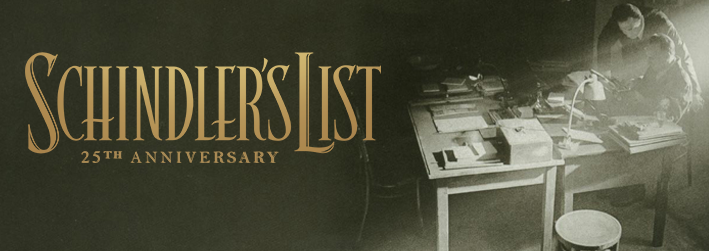
In honor of Universal Pictures’ rerelease of Schindler’s List, Echoes & Reflections has created a short, classroom-ready Companion Resource, that will help educators to provide important historical background and context to the film, as well as explore powerful true stories of rescue, survival, and resilience with their students.
Additionally, the following videos, recorded at Yad Vashem, feature Schindler survivors who speak of the impact Oskar Schindler had on their lives.
EVA LAVI TESTIMONY
NAHUM & GENIA MANOR
The posters feature the powerful words and experiences of Holocaust survivor and memoirist Elie Wiesel, Holocaust survivor Kurt Messerschmidt, and Anne Frank rescuer, Miep Gies. Each poster promotes meaningful conversation and reflection in the classroom, whether in person or in a virtual setting, and inspires students with powerful human stories of the Holocaust that can continue to guide agency and action as a result of studying this topic.
To support you in these efforts, we have also compiled several suggested classroom activities from teachers in our network that may be of use and interest.
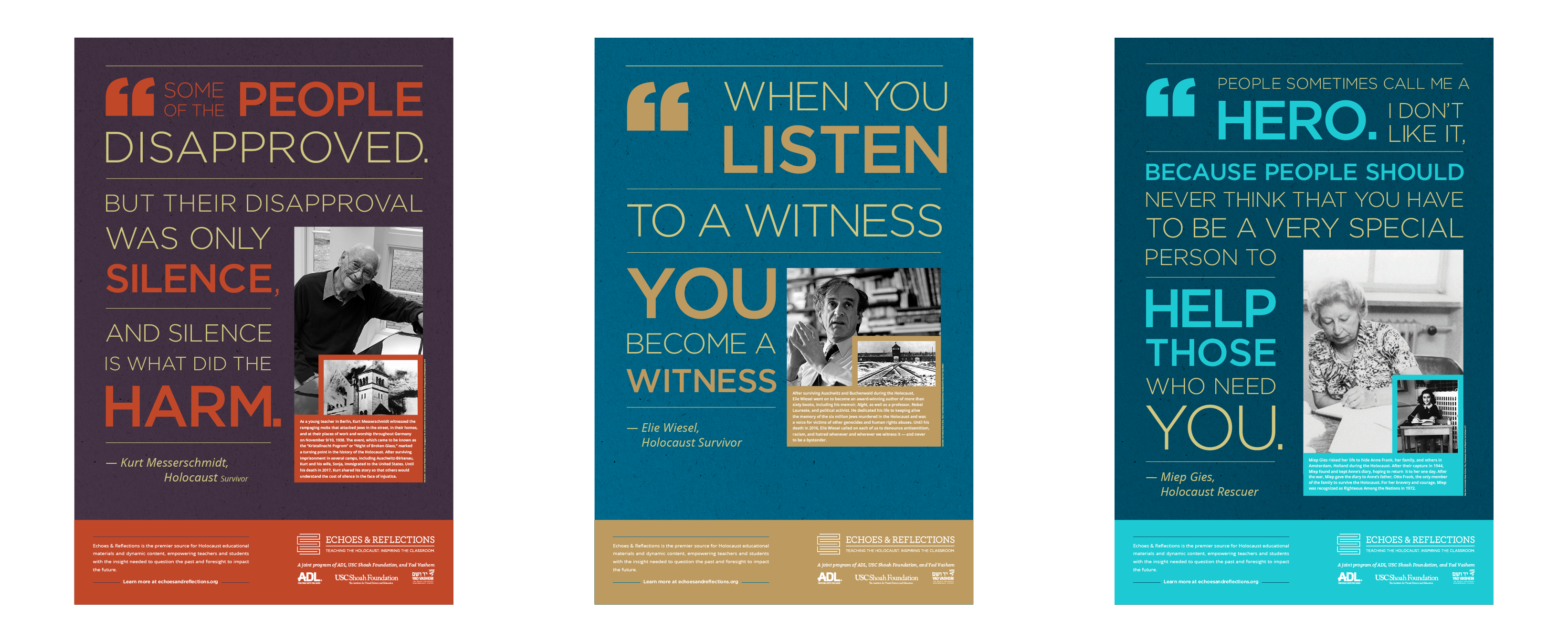
Please fill out the form below to access and download your PDF posters.

USC Shoah Foundation’s first podcast, We Share The Same Sky, seeks to brings the past into present through a granddaughter’s decade-long journey to retrace her grandmother’s story of survival. We Share The Same Sky tells the two stories of these women—the grandmother, Hana, a refugee who remained one step ahead of the Nazis at every turn, and the granddaughter, Rachael, on a search to retrace her grandmother’s history.
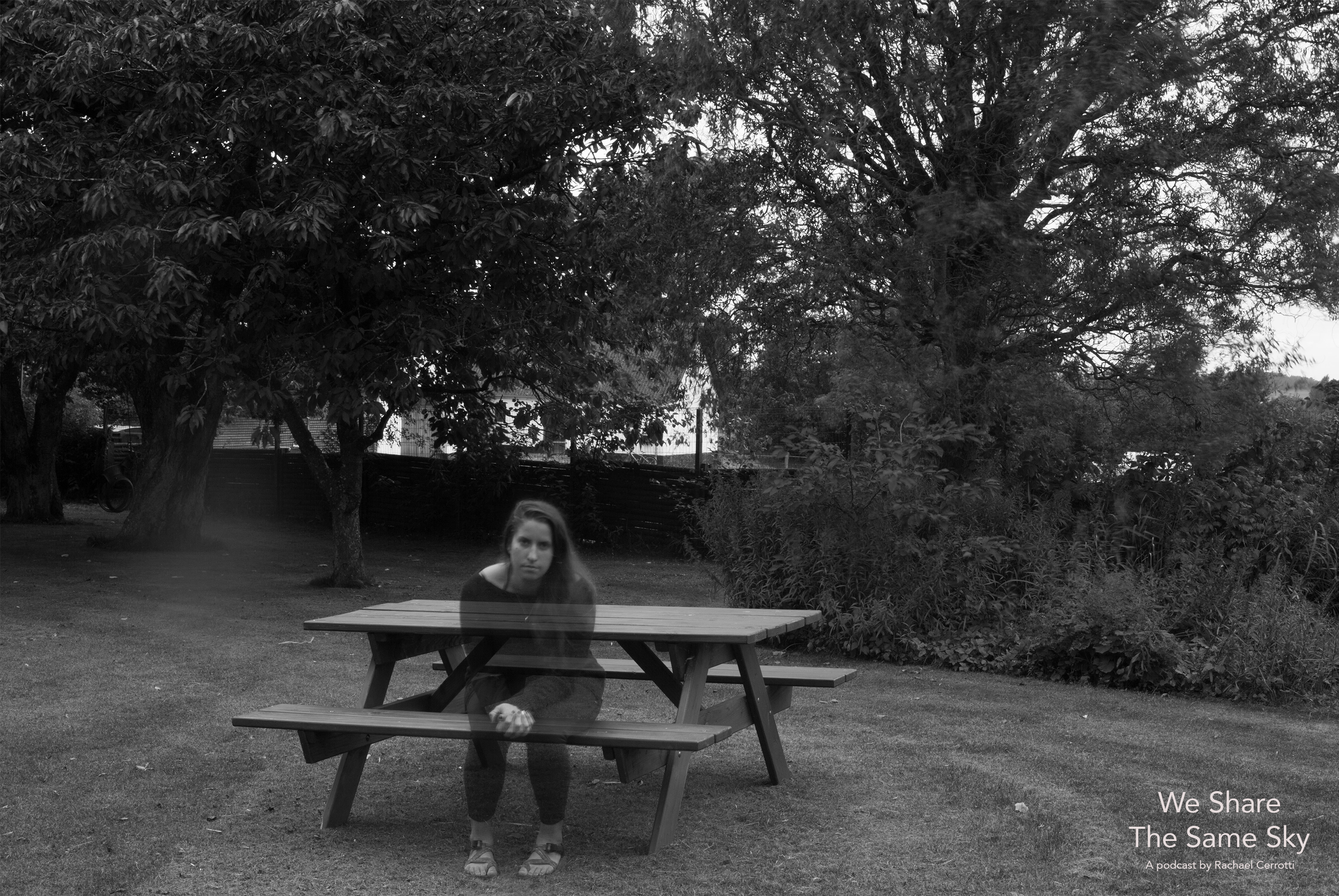
A self-portrait of Rachael while she is living on a Danish farm that is owned by the granddaughter of Hana’s foster mother from World War II. Photo by Rachael Cerrotti, 2017
In order to enhance its classroom use, USC Shoah Foundation and Echoes & Reflections have created a Companion Educational Resource to support teachers as they introduce the podcast to their students. This document provides essential questions for students, as well as additional resources and content to help build context and framing for students’ understanding of the historical events addressed in the podcast.
Access to the podcast, as well as additional supporting materials—including IWitness student activities, academic standards alignment, and general strategies for teaching with podcasts—can all be found at the We Share The Same Sky page in IWitness.
Note: Due to the subject nature, the podcast is appropriate for older students, grades 10-12. As always, teachers should review the content fully in advance to determine its appropriateness for their student population.

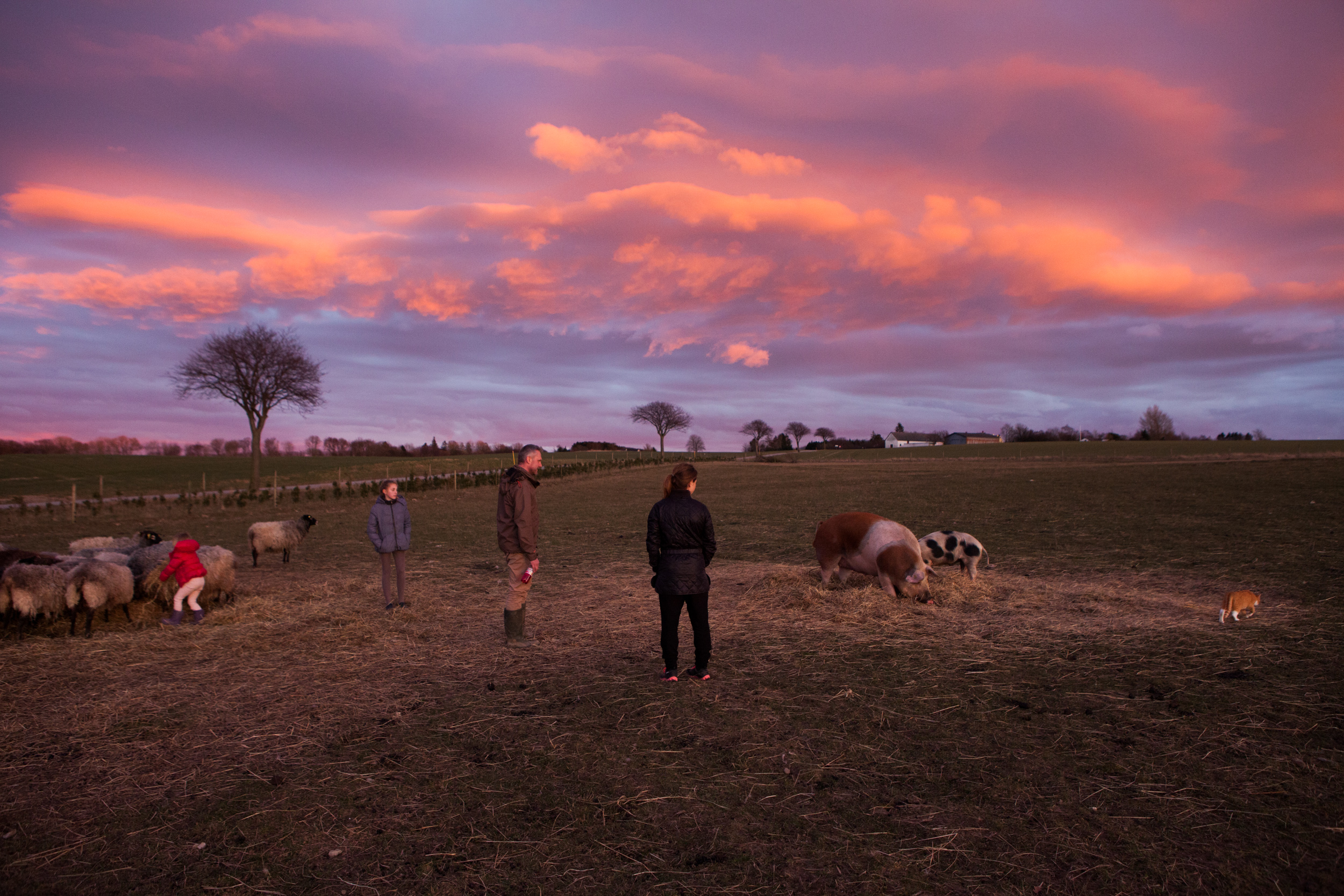
After many years of research and digitizing the archive her grandmother left behind, Rachael set out to retrace her grandmother’s 17 years of statelessness. Her intention was to travel via the same modes of transportation and to live similar style lives as to what her grandmother did during the war and in the years after. That meant that when she got to Denmark, she moved to a farm. Rachael moved in with the granddaughter of her grandmother’s foster mother from World War II and traded her labor for room and board as Hana once did. This picture is from that first visit in the winter of 2015. Since this time, Rachael has spent many more months living on this farm. It is owned by Sine Christiansen and her family. Sine is the granddaughter of Jensine, one Hana’s foster mother from World War II. Photo by Rachael Cerrotti, 2015
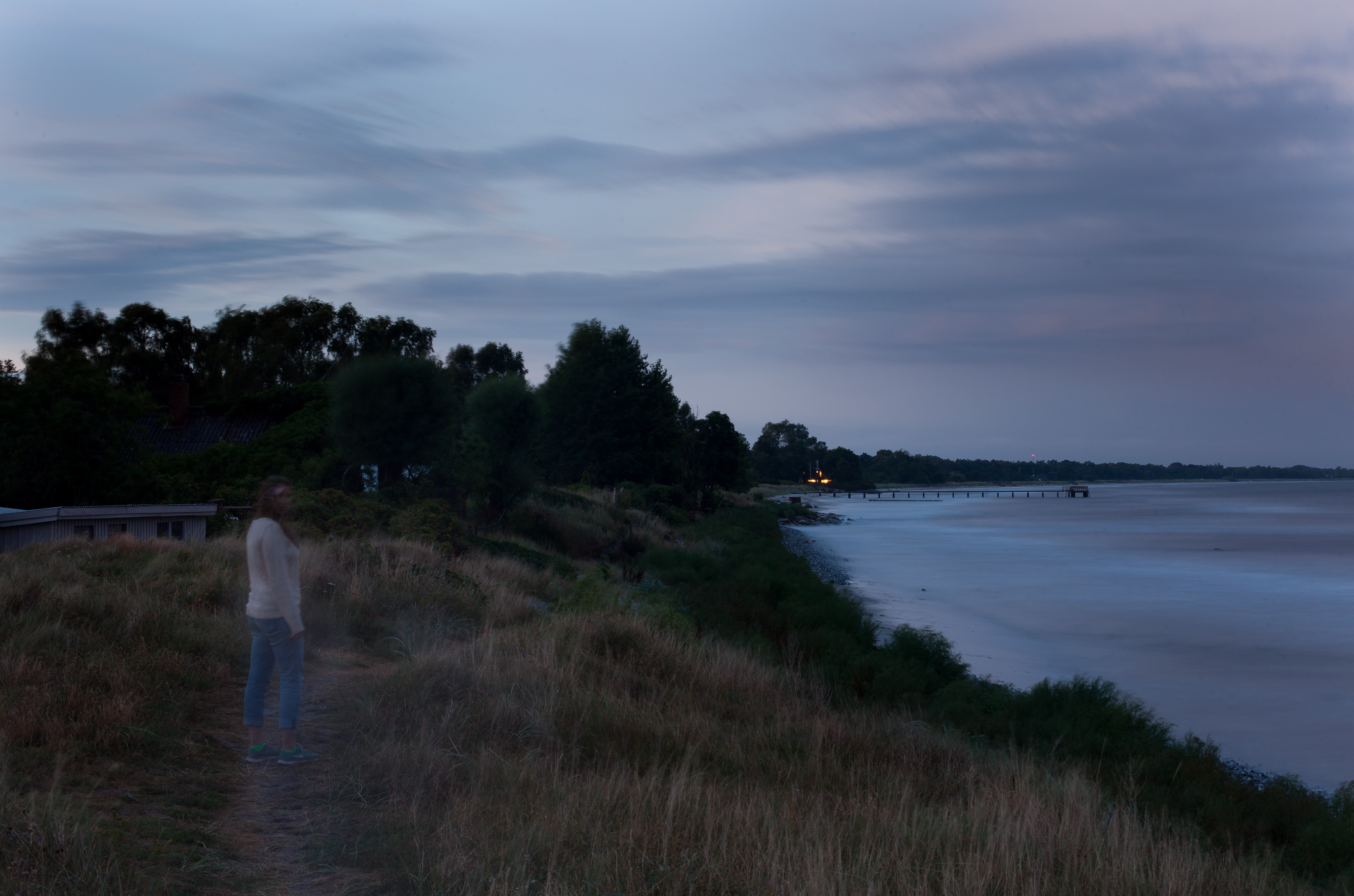
A self portrait of Rachael overlooking the exact spot in Southern Sweden where her grandmother’s refugee boat came to shore in 1943. Photo by Rachael Cerrotti, 2016



 English
English Español
Español
- ROMAN KENT, JEWISH SURVIVOR
Below is information to keep in mind when teaching the content in this unit. This material is intended to help teachers consider the complexities of teaching about Jewish resistance during the Holocaust and to deliver accurate and sensitive instruction.
|
|
This unit provides an opportunity for students to explore resistance efforts made by some Jews during the Holocaust, from the establishment of the ghettos through the implementation of the “Final Solution.” Students define resistance and investigate a wide range of examples, from cultural and spiritual resistance in the ghettos to armed revolt by partisans and concentration camp prisoners. Through analysis of visual history testimony, examination of primary source documents, and independent research, students consider how these forms of resistance demonstrate the capacity of Jews during the Holocaust to preserve their humanity in the face of extreme violence and inhumanity.
- How did some Jewish people resist Nazi oppression?
- What forms did resistance take during the Holocaust?
- What is the relationship between resistance and human dignity?
- Why did many choose to resist even when defeat or death was certain?
|
|
ACADEMIC STANDARDS
Academic and SEL Standards View More »
School Library Standards View More »

View More »
View More »
Testimony Reflections View More »
ACADEMIC STANDARDS
Academic and SEL Standards View More »
School Library Standards View More »

View More »
View More »
Reflexiones de los Testimonios Ver más »
90-120 minutes
90-120 minutes
LESSON 1: What is Resistance?
In this lesson, students define resistance and investigate wide-ranging examples of resistance by some Jews during the Holocaust. As they view visual history testimony and analyze primary source documents, students expand their understanding of resistance and consider the power of spiritual, cultural, and moral resistance in addition to physical and armed revolt.
| 1 | In pairs or small groups, students discuss the meaning of resistance and situations in which resistance is necessary. Based on their discussions, students record their definition of this term. |
| 2 | Students watch the Video Toolbox from 0:49-1:43 and then view the testimonies
of Jewish survivors who participated in resistance activities during the Holocaust:
[L]Helen Fagin[/L], [L]Ruth Brand[/L], and [L]Itka Zygmuntowicz[/L]. As they watch
the clips, students consider how each survivor resisted and take notes on the Testimony Reflections handout. |
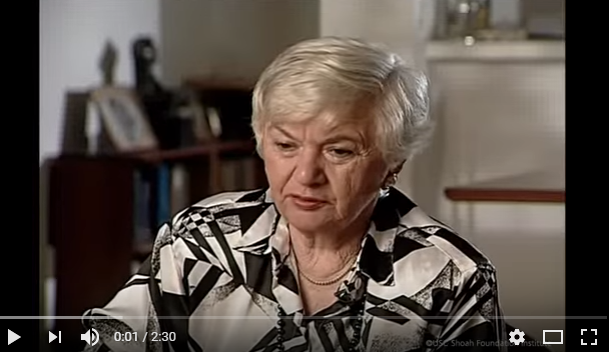
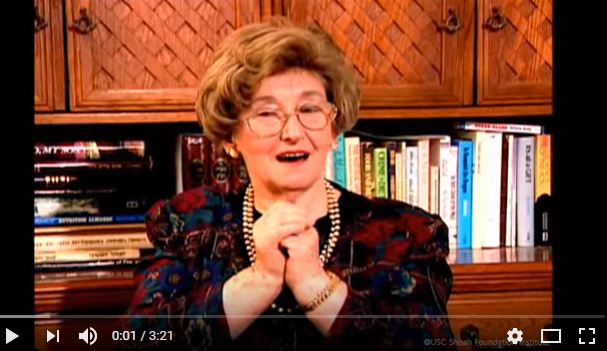
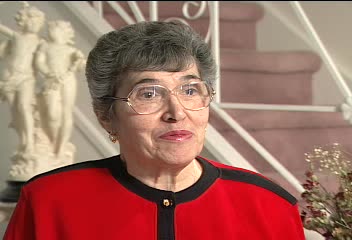



| 3 | After viewing the testimony clips, students journal and/or participate in a whole group discussion in response to some of the following questions: |
|
|
| 4 | In their pairs or small groups (formed in step 1), students consider which of the testimonies fit within their original definition of resistance. They revise their definitions to reflect new understandings. The class discusses their insights, including the limitations of thinking of resistance in purely physical terms. The following definitions from the Echoes & Reflections Audio Glossary are introduced as needed: resistance, armed resistance, spiritual resistance, cultural resistance. |
| 5 | The handout Jewish Resistance is distributed. In their small groups, students fill in their definition of resistance at the top. They begin to take notes in response to the other questions based on the testimonies they viewed and their prior knowledge. |
Jewish Resistance View More »
View More »
Teaspoons of Gunpowder View More »
Resistencia Judia Ver más »
View More »
Teaspoons of Gunpowder View More »
| 6 | In their groups, students read and analyze the documents below, representing different forms of resistance. They continue to add information and ideas to the Jewish Resistance handout and to refine their definitions of resistance.
|
Pronouncement by Abba Kovner View More »
Cultural and Spiritual Resistance View More »
| 7 | The class gathers to view the testimony of Jewish survivor [L]Roman Kent[/L]. Students add information and ideas to their Jewish Resistance handout one last time. They then journal and/or participate in a whole group discussion in response to some of the following questions: |
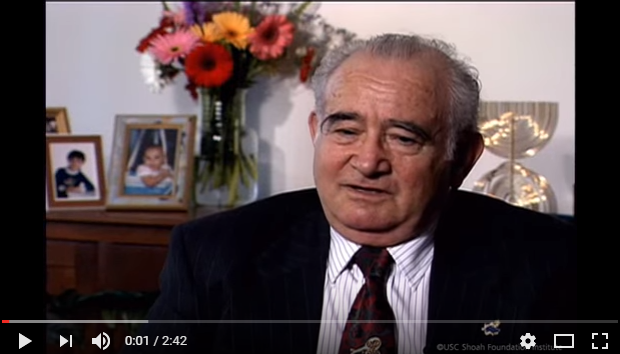
View More »

View More »
|
|
| 8 | As a summative task, students write reflectively in response to the following prompt: “How, if at all, has your understanding of resistance, especially as it pertains to the Holocaust, changed over the course of this lesson?” Students draw upon their Jewish Resistance handout and evidence from lesson sources to support their ideas. |
120 minutes
120 minutes
LESSON 2: Case Study – Resistance in the Warsaw Ghetto
In this lesson, students investigate the Warsaw ghetto as a site of resistance. They explore the factors leading to the Warsaw Ghetto Uprising and its significance to Jewish residents of Warsaw. Using texts, video, and visual history testimony, students examine other examples of spiritual, cultural, and armed resistance and consider how these forms of resistance were interconnected and mutually reinforcing.
| 1 | Prior to learning about resistance efforts in the Warsaw ghetto, students share their prior knowledge about the formation of and conditions in the ghetto. The Warsaw Ghetto handout is either projected or distributed, and the class reviews this brief background. Students learn that they will study the Warsaw ghetto as a site of resistance, and examine some of the many ways in which the Jewish residents fought for their dignity and their lives. |
| 2 | The handout Resistance in the Warsaw Ghetto is distributed. Students watch the Video Toolbox segment on the Warsaw Ghetto Uprising, from 7:52-13:50. As they view, students add notes to the handout. Following the video, the class discusses some of the following questions. |
Resistance in the Warsaw Ghetto View More »
Armed Resistance in the Ghettos and Camps View More »
View More »
Resistencia en el Gueto de Varsovia Ver más »
La Resistencia Armada en Los Guetos y Campos Ver más »
View More »
|
|
OPTION: Instead of or in addition to the Video Toolbox, students read the handout Armed Resistance in the Ghettos and Camps. ![]()
| 3 | Students continue to investigate examples of resistance in the Warsaw ghetto. Stations are set up as indicated in the Warsaw Ghetto Stations handout and a copy of the handout is placed in each area for student reference. In small groups, students visit at least two stations. For each, they continue to work with their Resistance in the Warsaw Ghetto handout introduced earlier in the lesson, or receive a new copy for this portion of the lesson. |
Warsaw Ghetto Stations View More »
Resistance in the Warsaw Ghetto View More »
| 4 | New small groups are formed that contain a mix of students who visited different stations. In those groups, students share highlights and insights from their investigation, and discuss the following questions:
|
| 5 | As a summative task, students reflect on Vladka Meed’s quote in the handout A Chain of Resistance. The handout is projected and read aloud. Individually, students journal in response to the following prompt: “What is the relationship between physical and spiritual resistance? How are they connected like links in a chain?” Students draw upon lesson sources as evidence for their ideas. As time allows, students share and discuss their reflections in pairs, groups, or as a class. |
90 minutes
90 minutes
LESSON 3: Independent Research on Resistance
In this lesson, students engage in independent research to deepen their understanding of Jewish resistance efforts during the Holocaust. In groups, students examine visual history testimony, primary source texts, and other resources on a topic, and create an artifact that represents what they have learned. Students gather their artifacts into a class exhibit and consider the meaning and impact of the actions taken by Jews to preserve their lives and humanity.
| 1 | In pairs, students discuss the following prompt: “What is an artifact? What is the role of an artifact in studying history?” Pairs share their thoughts with the larger class. The following ideas are highlighted:
|
| 2 | Students learn that they will complete an independent research project on a topic related to Jewish resistance, and create an artifact that represents what they have learned. The artifacts will be gathered into a class exhibition on Jewish resistance during the Holocaust. The handout Artifacts of Resistance is distributed and reviewed by the class. |
| 3 | Students form small groups and select a research topic from the Research Topics and Sources handout. In class and/or at home, they review the source material for their topic, record notes, and design their artifact and accompanying object descriptions. Students are encouraged to consult additional sources as needed to better understand their topic. |
| 4 | Groups’ artifacts are gathered into a class exhibit. The Artifact Reflection handout is distributed. Students participate in a “gallery walk” as follows: Half of the groups stand by their work and provide a brief tour or explanation of their artifacts to the other half, who circulate and observe; students then switch roles so that the tour guides become the observers. Students observe at least three artifacts in this way, completing the Artifact Reflection for each. |
| 5 | Following the gallery walk, the class debriefs using the following questions: |
|
|
| 6 | As a summative task, students imagine they are preparing an informational brochure and write a “Fact” to counter the “Myth” below. Their fact should explain why the statement is false and convey at least three ways in which Jewish people resisted during the Holocaust, drawing upon unit sources for evidence.
|
The ideas below are offered as ways to extend the lessons in this unit and make connections to related historical events, current issues, and students’ own experiences. These topics can be integrated directly into Echoes & Reflections lessons, used as stand-alone teaching ideas, or investigated by students engaged in project-based learning.
| 1 | During the Holocaust, many Jews resisted culturally by keeping their customs and traditions alive. Think about the role culture, traditions, and customs play in your life. Write about one or more traditions that are particularly important to you, explaining why they are important and how they have shaped – or continue to shape – your identity. |
| 2 | On November 20, 1942, Dolek Liebeskind, a commander of the Jewish underground in the Kraków ghetto, famously said: “We are fighting for the sake of three lines in history, [if only to show that] Jewish youth did not go like sheep to the slaughter. For this we find it worth our while even to die.” These words were spoken at a Sabbath dinner that Liebeskind’s group called “the Last Supper,” because they understood they were greeting the Sabbath together for the last time. The phrase became a rallying cry. Write a reflection on what you understand this statement to mean and how studying about resistance efforts during the Holocaust has influenced your understanding of these words and the sentiment they express. |
| 3 | Throughout history, music has been used as a form of resistance. During the Holocaust, Jews secretly composed and performed music to uphold traditions, escape their harsh existence, and document ghetto life. One composition, “Never Say,” created by Hirsh Glick, became the official song of the partisans. It was translated into several languages and was well known in both the ghettos and concentration camps. Listen to the “Never Say” audio recording. Identify specific words, phases, or lines that reveal Glick’s intended audience and message(s). Research one additional song that was part of the Jewish resistance and write a brief report summarizing the language, mood, and message of the song. Sources include: Music of the Holocaust (Yad Vashem), and Music of the Holocaust (USHMM). |
| 4 | Using a variety of print and digital sources, research additional examples of underground movements or partisan resistance during World War II: Italian, Slovakian, Polish, French, Yugoslavian, and others. Prepare a written, oral, or multimedia presentation summarizing your findings and identifying how the movement was both different from and similar to the Jewish resistance movements. |
| 5 | Gather relevant information from print and digital sources about resistance efforts by enslaved Black people in the 17th and 18th centuries or interned Japanese Americans during World War II and prepare a multimedia presentation. Include information about different types of resistance (e.g., armed, spiritual, and cultural) and feature a variety of source materials (e.g., news articles, photographs, interviews). |
British Mandate/British Mandatory Palestinecollaboratorconcentration campcrematoriacultural resistancedeath marchdeportationextermination camp
Gestapo
ghettoHolocaustJudenrat
Majdanek
Molotov CocktailNaziOneg Shabbat Archive
partisansrefugee
spiritual resistanceStar of DavidTreblinka
undergroundWarsaw ghettoWarsaw Ghetto UprisingYiddishYom KippurZ.O.B.







